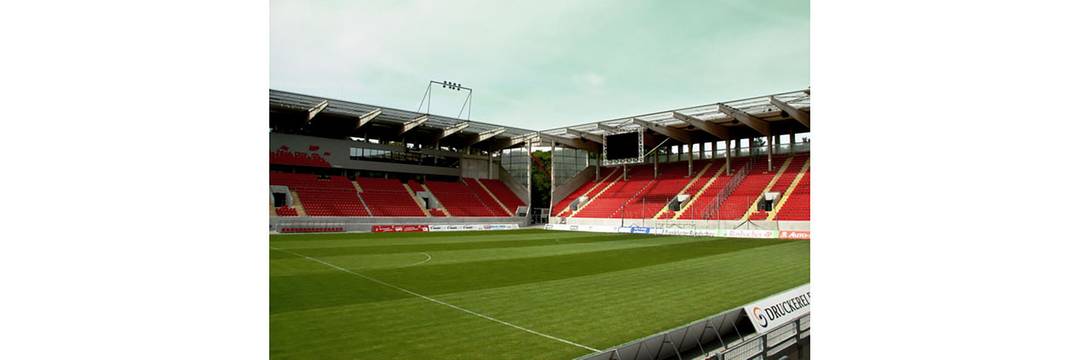
The Offenbach Kickers of Germany Score With Q-Sys™
New Soccer Stadium Relies On Q-Sys™ Integrated System Platform
Offenbach, Germany (July 2012) – Founded in 1901, the soccer team Offenbach Kickers is renowned throughout Germany for its fiercely dedicated legions of fans who have supported the club through its many ups and downs. Now the Kickers, based in western Germany near Frankfurt, have a new home — a futuristic, 25-million Euro stadium sponsored by the local Sparda Bank in their native German state of Hesse. The stadium houses a QSC Q-Sys™ integrated system that controls, routes and processes all of the audio feeds and systems in the new ground.
With four weatherproof, covered spectator stands in the style of recently constructed English stadiums, capacity for over twenty thousand spectators, 10 VIP boxes, a special reception area for business club members and various fashionable retail outlets, the state-of-the-art new Sparda Bank Stadium has now been completed in time for the club's 111th anniversary.
Improvements to the outdated, underpowered audio playback systems at the Kickers' home ground were high on the list of fans' requirements before reconstruction began, and the new Sparda Bank Stadium has not disappointed. The Q-Sys platform controls all the audio in the stadium from the main operations centre, including the associated PA/VA system. QSC equipment is also used to power the loudspeakers hanging in the stadium eaves. QSC PowerLight™ amps, in service for many years at the Kickers' old stadium, have been re-commissioned for use in the new facility, following extensive performance testing at the headquarters of the QSC distributor in Germany, Shure Distribution. A QSC CX302 power amp was additionally purchased to power new fill-in loudspeakers at the outlying reaches of the stadium.
Cable runs in a large stadium can be up to several hundred meters, particularly in this case where each spectator stand has its own control centre. The centre in the main stand also acts as the audio control centre for the whole ground, and houses the Q-Sys Core 1000 processor. This is linked to the other control rooms via a fibre-optic cable network which allows full integration with the Q-Sys I/O Frames in the individual stand control centres. These in turn act as the audio I/O boxes for the inputs and outputs in each stand, converting the analogue signals to digital and back as required.
Most of the design work on the Q-Sys platform at the Sparda Bank stadium was carried out according to the club's requirements using the Q-Sys Designer software before installation took place on site. The completed design was loaded into the Core 1000 unit when the units were installed at the stadium, and final adjustments were then made to accommodate the practical realities of the installation.
All the audio systems in the ground can now be adjusted and controlled from a wireless-connected laptop if required — a state-of-the-art solution for a state-of-the-art stadium. Looking back, Alexander Hülshorst, head of the stadium reconstruction project at the design and construction company Beckhoff Technik GmbH, commented, "I've never worked with an audio networking platform that was so easy to integrate as Q-Sys."